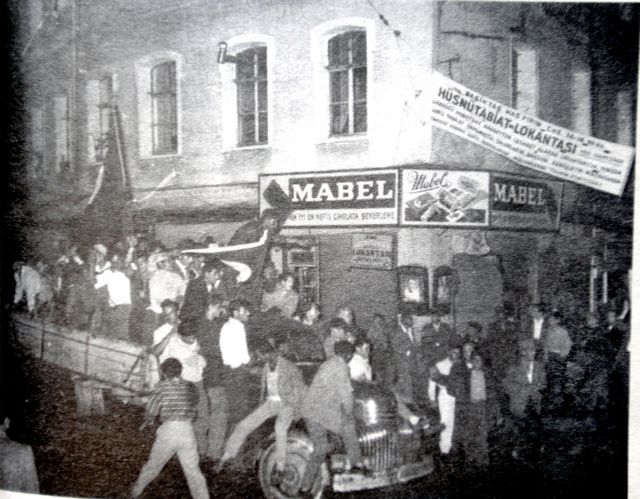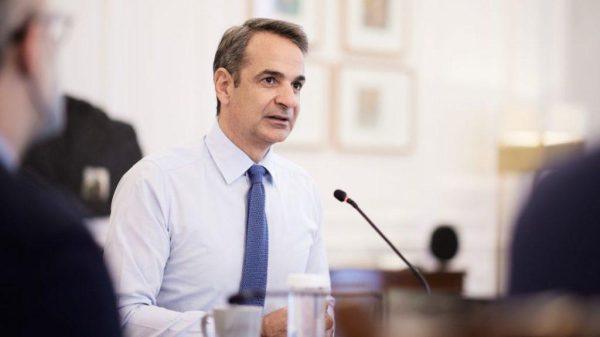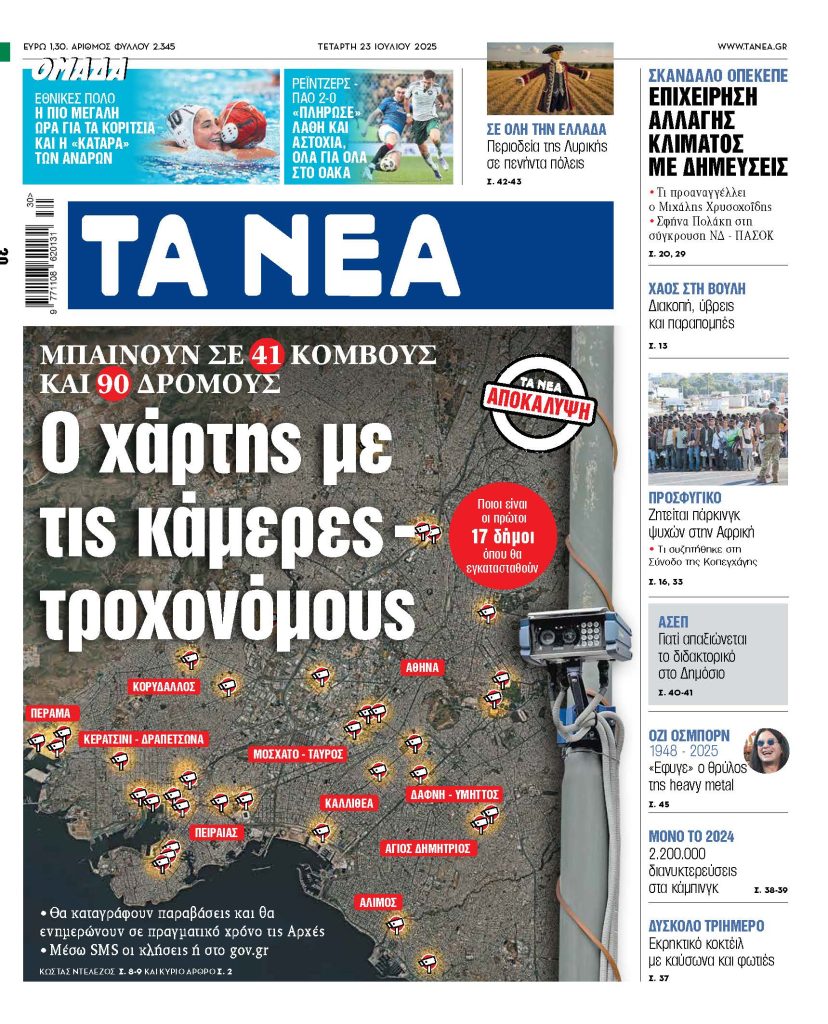By George Gilson
What those who met him remember best about Speros Vryonis, one of the most beloved and respected members of the Greek-American community who died on 11 March at age 90, is the kindness and gentleness of character of one of the top Byzantinists of his generation whose scholarly activity and publications covered a dazzling array of subjects.
These include Seljuk and Ottoman history, Balkan history, the Arab world, Byzantium’s relations with Islam, the spiritual tradition of mediaeval Hellenism in the Slavic and Islamic world, the decline of mediaeval civilization in Asia Minor and the process of Islamification, continuity and change in the Balkans, Islam and cultural change in the Middle Ages, and Islam’s understanding of itself.
In brief Vryonis’ academic work touched on nearly all aspects of Hellenism and the cultures that interacted with it throughout history.
One of Vryonis’ most important works was his monumental study on the September, 1955 pogrom against the then flourishing and illustrious Greek minority of Istanbul.
The Mechanism of Catastrophe: The Turkish Pogrom of September 6 – 7, 1955, And The Destruction Of The Greek Community Of Istanbul , the product of many years of research and access to Turkish state archives that touched on the issue (Vryonis was fluent in Turkish), was the first treatment of the events that led to the expulsion of the Greeks of Istanbul that proved with incontrovertible historical documentation that the pogrom that destroyed the Greek minority was a state-designed and executed plan with the active participation of Turkish Prime Minister Adnan Menderes and his Demokrat Parti.
What follows is this writer’s presentation of that seminal work that was published in the Athens News in June, 2005:
The fiftieth anniversary of the September 6-7 pogrom that destroyed Istanbul’s illustrious Greek minority could scarcely have had a more monumental commemoration than Professor Speros Vryonis’ exhaustive new study – The Mechanism of Catastrophe: The Turkish Pogrom of September 6-7, 1955, and the Destruction of the Greek Community of Istanbul (Greekworks. com, 2005). The eminent Harvard-trained Byzantinist, who after UCLA completed a long stint as director of the Onassis Centre in New York, first followed the 1955 events analysed in his book’s 650 pages, from the foreign press, while at Dumbarton Oaks in Washington DC.
He noted that reports, which praised Turkish state intervention to restore order only after disaster had been wreaked, reflected the official government reaction. In the following decades Vryonis collected a host of primary and secondary sources that documented the highly organised state violence aimed at the ethnic cleansing of the Greek community.
The book includes a plethora of invaluable photos of the destruction by Ecumenical Patriarchate photographer Demetrios Kaloumenos, who documented the horrendous results of the pogrom attacks.
Vryonis takes pains to thrash out the complex political and economic context of the pogrom both domestically and internationally, from the Cold War setting that led allies Britain and the US to absolve Turkey’s Menderes government of the direct political blame that it was due, to the complex way that the Cyprus problem was used by Ankara as a propaganda tool to fan the flames of chauvinist nationalism and religious intolerance against the Greeks.
Vryonis documents how, against a backdrop of severe economic woes, Menderes and his hardline foreign minister, Fatin Zorlu, mobilised the formidable machinery of the ruling Demokrat Parti (DP) with the crucial collaboration of the party-controlled trade unions of Istanbul, to destroy within a period of nine hours – and under the supervision of interior minister Namik Gedik – over 4,000 Greek businesses and over 3,000 Greek homes.
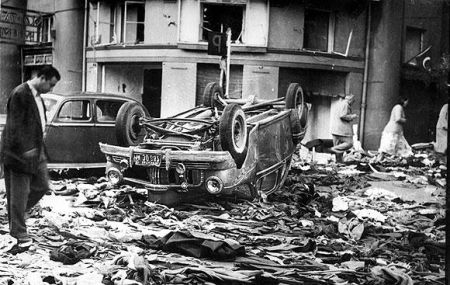
British diplomatic sources put the damages at 100 million pounds. The task was completed eight years later, when thousands of Greek nationals or “etablis” (most born in Turkey and a high percentage married to Greek Turkish citizens) were deported when Ankara
withdrew from a 1930 Greek-Turkish convention establishing their right to live and work in Turkey. Today, the Greek community appears destined for extinction, since there remain in Istanbul fewer than 2,000 mostly older Greeks, the remnants of the once 150,000-strong minority.
Vryonis offers an in-depth analysis of how the Greek push for self-determination in Cyprus, where Greek-Cypriots constituted 83 percent of the population, provided a convenient basis for a state-supported propaganda campaign that – with the involvement of the Turkish press – galvanised public opinion against the Greek minority.
That included rumours spouted even by Menderes himself that the Greek-Cypriots planned to massacre Turkish-Cypriots on August 28, barely two weeks before the Istanbul pogrom. The Turkish conspiracy to detonate an explosive on September 5-6 at the Turkish consulate in Greece’s northern port city of Thessaloniki, reputed to be the birthplace of Kemal Ataturk, was the propaganda spark that lit the fire on the day of the pogrom.
At the 1960-61 Yassiada trial that convicted Menderes and Zorlu to death by hanging for violating the constitution (the pogrom was a secondary factor for which they were blamed at the trial), it emerged that the consulate bomb fuse was sent from Turkey to Thessaloniki on September 3, three days before the pogrom. The evidence, however, shows that highly orchestrated attacks by a mob of 300,000 (the div cited by Zorlu’s lawyer at the Yassiada trial) in a radius of 40 miles was planned considerably earlier and marshaled the formidable apparatus of the ruling party.
Vryonis places the pogrom in the context of the Young Turks’ traditional programme, that of removing all minorities in order to achieve the Turcification of the entire country. The forced conscription of Greeks and Jews (males aged 18-45) who were placed in forced heavy-labour battalions in 1941 and the punitive varlik vergisi capital tax in 1942 that sent thousands of Greeks, Jews and Armenians who could not pay to the harsh snow-bound labour camps of Ashkale ( a Turkish Siberia) were two prime examples. Earlier, in 1932, a parliamentary law barred Greek citizens living in Turkey from a series of 30 trades and professions (from tailor and carpenter to medicine, law and real estate). “A series of some 31 laws during the period between the two world wars severely crippled and, finally, paralysed the community as a result of these efforts to reduce its political, legal, economic and cultural presence,” Vryonis notes.
British charge d’affaires Michael Stewart directly implicates Menderes’ Demokrat Parti (DP) in the execution of the attack. “There is fairly reliable evidence that local Demokrat Parti representatives were among the leaders of the rioting in various parts of Istanbul, notably in the Marmara islands, and it has been argued that only the Demokrat Parti had the political organisation in the country capable of demonstrations on the scale that occurred,” said Stewart, but he refused to assign blame to the party as a whole or Menderes personally.
The book documents the direct role of the DP chapters in amassing the army of rioters that swept Istanbul, with the case study of Eskishehir among the most telling examples. There the party recruited 400-500 workers from local factories, who were carted by train with third class-tickets to Istanbul. They were accompanied by Eskishehir police, who were charged with coordinating the destruction and looting once the contingent was broken up into sub-groups of 40-50 men, and the leaders of the party chapters. The numbers would suggest that thousands were recruited from western Asia Minor. The evidence shows that the workers were promised the equivalent of $6, which was never paid.
The crucial role of the government-controlled trade unions of Istanbul and surrounding areas in executing the pogrom is thoroughly documented in the book, which reveals how Menderes denied access to the minutes of meetings of the unions and of the local DP chapters.
Tools of destruction and nationalist recruits
Municipal and government trucks were placed in strategic points all around the city to distribute the tools of destruction – shovels, pick axes, crowbars ramming rods and gasoline – while 4,000 private taxis were requisitioned to transport the pogromists.
The ruling party also recruited student and irredentist organisations that played a role in the vitriolic attacks against the Greek minority. The National Federation of Turkish Students and the National Union of Turkish Students were used since 1954 to attack the minority and the Ecumenical Patriarchate through demonstrations and demands. The Cyprus is Turkish
Organisation, with 18 chapters in Istanbul (10 run by DP officials), had direct links to Menderes and played a crucial role in whipping up anti-Greek
hatred.
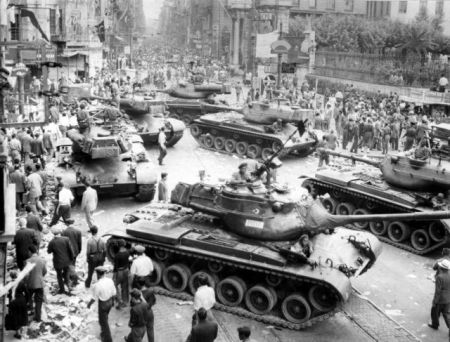
Whereas the pogrom started around 5pm on September 6, with the many Greek shops on Istanbul’s main shopping treet, Istiklal, ransacked by the mob by 7pm, the army only intervened after midnight. Eyewitnesses reported that earlier army officers and policemen participated in the rampages and in many cases urged them on.
Greek dentist Anestes Chatzeandreou’s eyewitness account is characteristic. “I saw a raging mob of Turks, about 25-30 of them, holding iron crowbars, shafts,
clubs, and they were smashing the stores and doors of the houses right and left, smashing the glass panes and display windows while shouting ‘Death to the Gavurs’ [infidels] and ‘Massacre the Greek traitors’. At 10.10pm, we cautiously went out and the first thing we saw was a vast brightness to the east, exactly over Istanbul’s Greek area of Pera, a sign of arson used by the
Turks to cover the orgy of stealing and looting.”
Housewife Gedikouliane Ioannidou-Moysidou recounted how Greek Christian houses were marked for destruction in advance. “They had marked all the Greek houses with the letter ‘X’, which meant here lives a Christian. They had no difficulty finding us for everything had been planned ahead of time… They brought from Anatolia all the barbarians, whom they instructed on how to
smash, destroy and steal,” she said.
The pogromists were instructed not to kill, but about 13 Greeks, including a bishop, died from the severe beatings. Dozens of Greek women and some young men were raped. A number of men, mainly priests, were subjected to circumcision by frenzied members of the mob, according to the account of Turkish writer Aziz Nesin. An Armenian priest died after the procedure.
On many commercial streets the mounds from the smashed and torn merchandise dragged into the streets from Greek stores rose to nearly a metre.
Eyes shut on pogrom
Vryonis describes the disappointing results of Greece’s efforts to internationalise the tremendous human rights violations through international organisations such as the UN and Nato. In Izmir Greek officers and their families were attacked and their homes pillaged. But the Greeks found little sympathy. British Nato representative Cheetham deemed it “undesirable” to probe the pogrom. US representative Edwin Martin thought the effect on the alliance was exaggerated, and the French, Belgians and Norwegians urged the Greeks to “let bygones be bygones”. Indeed, the Nato Council issued a statement that the Turkish government had done everything that could be
expected.
As for compensation, the Greeks ended up receiving about 20 percent of claims that had already been vastly reduced from the actual cost of the devastating
damages.
The interest of international religious groups such as the World Council of Churches was much more substantial, as 90 percent of Istanbul’s Greek Orthodox churches were attacked, many destroyed entirely by arson and rampant vandalism. The author stresses the religious fanaticism evident in the attacks, a phenomenon which Menderes had fuelled with his un-Kemalist support
of and reliance on Islamist forces, as evidenced by the building of 1,000 mosques during his tenure. Menderes’ lack of religious observance of the Kemalist tenets was a sin for which he paid with his life.
Half a century after the pogrom, Vryonis concludes that the Turkish military establishment’s continuing stranglehold on power has prevented the respect for human rights that might have been the lesson of the pogrom. “The ‘success’ of the Turkish military behemoth during the last fifty years, has in fact made the Turkish state a persistent violator, not only of the human and civil
rights of its minorities, but also of those of its vast ethnic Turkish majority,” Vryonis concludes.
Excerpts from the ‘Mechanism of Catastrophe’
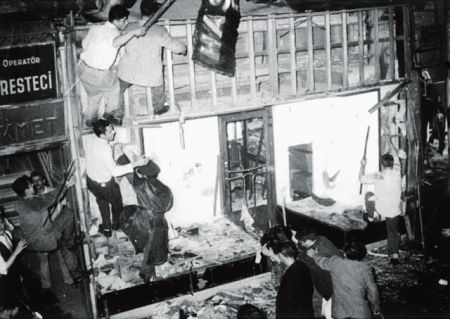
Ecumenical Patriarch Athenagoras’ letter to Turkish PM Adnan Menderes.
November 15, 1955
The very foundation of a civilisation which is the heritage of centuries, the property of all mankind, has been gravely attacked. The sacred things of our religion have been defiled, seventy of our churches and houses of worship destroyed and most of them set on fire. Our sacred objects of religion were desecrated, floundered and plundered. The graves of our dead, including those of the Patriarchs were broken open. Newly buried corpses were torn to pieces, the bones of the dead removed from their resting places, scattered around and set on fire.
Our clergy men were everywhere persecuted. When found they were manhandled, threatened with killing, and one of them was actually put to death. The immunity of private dwellings was violated, virgins were ravished, and even the sick, old and children were maltreated. All of us, without any defence, spent moments of agony, and in vain sought and waited for protection from
those responsible for order and tranquillity.
‘Daily Mail’ report of September 14,1955, by Noel Barber
The church of Yedikule was utterly smashed, and one priest was dragged from bed, the hair torn from his head and the beard literally torn from his chin. Another old Greek priest in a house belonging to the church and who was too ill to be moved was left in bed, and the house was set on fire and he was burned alive. At the church of Yenikoy, a lovely spot on the edge of the Bosphorus, a priest of 75 was taken out into the street, stripped of every stitch of clothing, tied behind a car and dragged through the streets. They tried to tear the hair of another priest, but failing that, they scalped him, as they did many others.
Turkish author Azis Nesin
A man who was fearful of being beaten, lynched or cut into pieces would imply and try to prove that he was both a Turk and a Muslim. “Pull it out and let us see,” they would reply. The poor man would peel off his trousers and show his “Muslimness” and “Turkishness: And what was the proof? That he had been circumcised. If the man was circumcised, he was saved. If not, he was “burned”. Indeed, having lied, he could not be saved from a beating. For one of those aggressive young men would draw his knife and circumcise him in the middle of the street and amid the chaos. A difference of two or three centimetres does not justify such a commotion. That night, many men shouting and screaming were Islamized forcefully by the cruel knife. Among those
circumcised there was also a priest.
Damage survey report by Demetrios Chronopoulos for Greek Defence Minister Panagiotes Kanellopoulos
Taking into account the dreadful economic crisis that troubled Turkey prior to the pogrom in Constantinople, one can only describe as ironic the announcement of Turkish President Bayar that “the victims of the destruction shall be compensated”. According to the more cautious evaluations, the amount of damages is close to $500,000,000. And it is impossible for the Turkish government to pay out even a portion of this. I am informed that private insurance does not exist in Turkey, as a result of which insurance is provided by the State. Under such circumstances, there is no possibility that the victims will be compensated.
